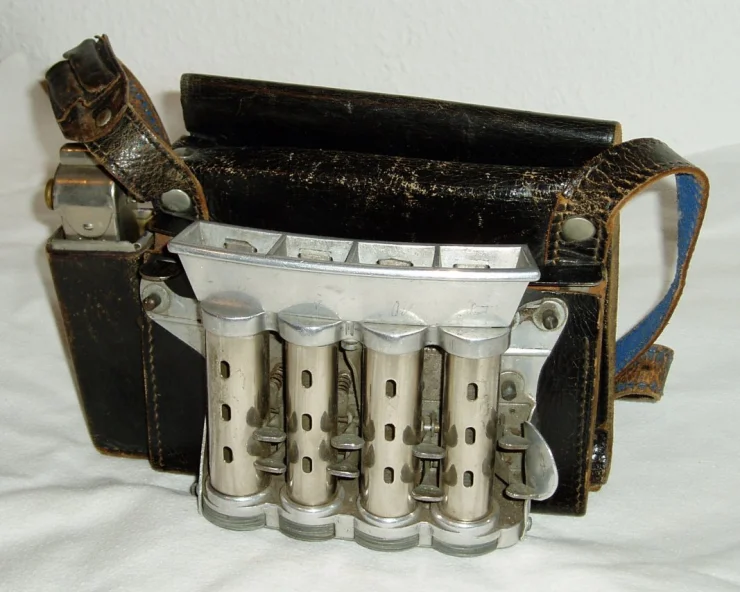If you’ve ever watched a classic movie or a vintage newsreel, you might have noticed a bus driver, street vendor, or train conductor with a peculiar little contraption on their belt. This odd gadget was known as a belt change dispenser, a tool that made dispensing coins quick and easy for workers on the go. These devices, which were once essential for anyone handling cash in small denominations, have become a charming relic of the past. But what exactly were they used for, and what happened to them?
A Brief History: When and Why Belt Change Dispensers Were Invented

Belt change dispensers were invented as a practical solution for cash handlers in the early 20th century. These devices first became popular with Jacques L. Galef’s design, patented around 1921. Galef’s invention addressed a very specific need: people who dealt with small transactions required a quick, efficient way to handle change.
Imagine the daily routine of a bus conductor or a street vendor in the 1920s or 1930s. With constant small cash transactions and limited time, quickly dispensing the correct amount of change was essential. The belt change dispenser streamlined this process, saving precious seconds with each customer interaction. Not only was this faster, but it also minimized the potential for human error—a significant advantage in an era before computerized cash registers.
How Did Belt Change Dispensers Work? The Ingenious Simplicity Behind the Mechanism
The beauty of the belt change dispenser lies in its simplicity. Each dispenser typically featured a set of spring-loaded barrels, one for each coin denomination. The user would wear the device on a belt around their waist, with each barrel holding a different type of coin, such as pennies, nickels, dimes, or quarters.
When it came time to dispense change, the user simply pulled the lever corresponding to the desired denomination. The lever, attached to a spring mechanism, would open a small gate at the bottom of the barrel, allowing one coin to fall into the user’s hand. No batteries, no electronics—just a simple mechanical setup that worked flawlessly in countless everyday scenarios.
Refilling the dispenser was just as easy. When a barrel ran out of coins, the user opened the clasp on top and dropped in a fresh roll of coins. The average belt change dispenser could hold around a roll’s worth of each denomination, making it perfect for the high-volume cash handling tasks of the time.
Who Used These Dispensers? Professions that Relied on Belt Change Dispensers
While belt change dispensers were used across various industries, they were most commonly associated with the following professions:
- Bus and Train Conductors: Public transportation workers used belt change dispensers to quickly provide exact change to passengers, making the boarding process more efficient.
- Street Vendors: Whether they were selling newspapers, ice cream, or snacks, vendors could make transactions without needing a cash register.
- Ticket Sellers: From movie theaters to carnivals, ticket sellers relied on these devices to handle a steady stream of small cash payments.
- Parking Attendants: Change dispensers allowed parking attendants to provide quick change for drivers, making the process of paying for parking smoother and faster.
These dispensers were a practical and highly visible part of everyday life, particularly in the mid-20th century. It’s hard to imagine the efficiency they provided before modern conveniences like digital payment systems and point-of-sale (POS) devices.
Why Did Belt Change Dispensers Disappear? The Fall of a Practical Gadget

As technology evolved, so did the way we handle money. By the 1970s and 1980s, belt change dispensers began to lose popularity. Several factors contributed to their decline:
- Introduction of Digital Cash Registers: With electronic registers, cashiers no longer needed to carry change on their person, as change dispensers became part of the cash drawer.
- Shift to Card Payments: The rise of credit and debit cards reduced the need for coins in everyday transactions, decreasing demand for coin-specific tools.
- Self-Serve Machines: Innovations like vending machines and automated ticket dispensers eliminated the need for human attendants to handle small transactions, further reducing the use of belt change dispensers.
- POS Terminals and Portable Payment Solutions: Modern portable payment terminals have replaced the need for quick-change mechanisms, especially with mobile and card payments becoming increasingly common.
Over time, belt change dispensers became a nostalgic item rather than a practical tool, symbolizing a bygone era when cash ruled and coins were essential for everyday commerce.
Where Are Belt Change Dispensers Now? A Look at Their Collector Appeal
Today, belt change dispensers are considered vintage collectibles, sought after by antique enthusiasts and history buffs alike. You can still find these devices at antique stores, vintage fairs, and online marketplaces like eBay or Etsy. Some collectors are drawn to their retro aesthetic, while others appreciate the functionality and engineering that went into their design.

For anyone with a fondness for historical gadgets, a belt change dispenser makes for a unique and charming piece. These dispensers aren’t just relics of a time when handling cash was manual—they’re also a reminder of the hardworking people who used them in daily life. From bus conductors to popcorn vendors, countless hands once relied on these devices to get through their busy shifts. Today, they serve as nostalgic reminders of a simpler, cash-centric world.
Conclusion: Reflecting on the Legacy of Belt Change Dispensers
Belt change dispensers played an essential role in everyday life during the mid-20th century. While they may seem quaint by today’s standards, they were highly functional tools that kept commerce moving. Their simple design and practicality make them a beloved item among vintage collectors, and their legacy endures as a symbol of a time when technology was more hands-on.
In an age dominated by digital payments, it’s fascinating to look back on the tools that once made transactions faster and more efficient. Belt change dispensers are a small but important reminder of how much technology has changed—and how much we’ve gained (and lost) along the way.


